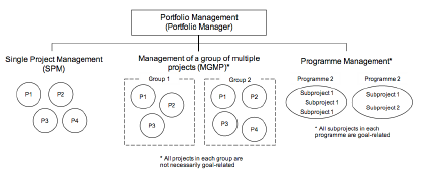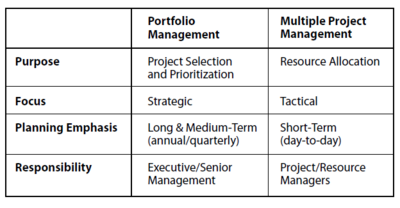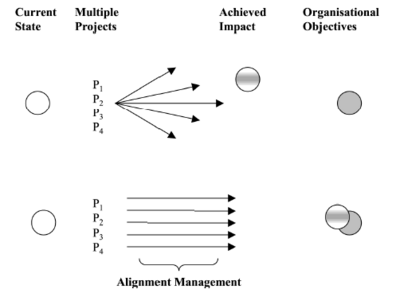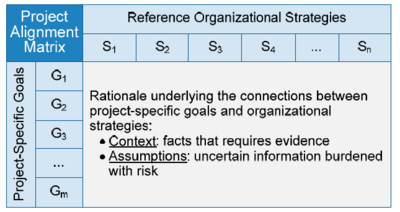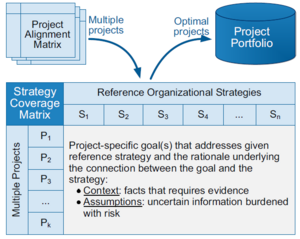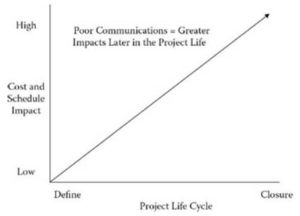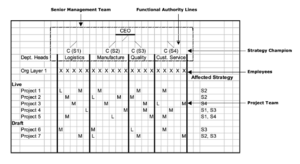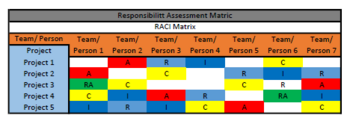Effective Tools for Multiple Project Management
Manas Dalvi (Talk | contribs) |
Manas Dalvi (Talk | contribs) |
||
| Line 100: | Line 100: | ||
| − | [[File:Fig8MPM.PNG|left|thumb|Fig8:RACI Matrix (This is demonstrational matrix created for reference and is not adopted from any of the online literatures)|350px]] This matrix describes the projects, their respective leaders and members, however it does not define the responsibilities of each individuals. An improvised version of responsibility matrix can be used where clear responsibility of each individual can be clearly defined. This matrix is generally referred to as Responsibility Assessment Matrix or RACI Matrix. RACI is a derived abbreviation for Responsibilities, Accountability, Consult and Informed, which are key responsibilities for achieving project objectives. However, this matrix offers managers freedom to modify the matrix as per their requirement. This can be addition to the four key responsibilities or it can be an altogether different responsibility. | + | [[File:Fig8MPM.PNG|left|thumb|Fig8:RACI Matrix (This is demonstrational matrix created for reference and is not adopted from any of the online literatures)|350px]] This matrix describes the projects, their respective leaders and members, however it does not define the responsibilities of each individuals. An improvised version of responsibility matrix can be used where clear responsibility of each individual can be clearly defined. This matrix is generally referred to as Responsibility Assessment Matrix or RACI Matrix. RACI is a derived abbreviation for Responsibilities, Accountability, Consult and Informed, which are key responsibilities for achieving project objectives. However, this matrix offers managers freedom to modify the matrix as per their requirement. This can be addition to the four key responsibilities or it can be an altogether different responsibility. Following are the some of the alternatives to RACI matrix for responsibility assessment. |
| − | + | ||
| − | Following are the some of the alternatives to RACI matrix for responsibility assessment. | + | |
*RASIC (Responsibility-Accountability-Support-Informed-Consult) | *RASIC (Responsibility-Accountability-Support-Informed-Consult) | ||
Revision as of 21:49, 18 February 2021
Contents |
Abstract
Due to exponential advancements across various sectors, project management professionals are expected to manage a portfolio of projects in their respective organizations due to limitation for resources. These portfolios can be interdisciplinary at times and their individual status in the cycle would differ. During such times it becomes difficult for these professionals to run parallel with these updates. Losing focus may lead to build an ineffective strategy, non-optimized resource management, lack in control and communication, etc. which would further affect the performance of the individual and also of the organization as a whole.
This article gives an insight of Multiple Project Management (MPM), its necessity, classifications and causes for ineffective MPM. Moreover, it further explains the methodologies that one must consider while resolving these causes. In the view of limited empirical research on MPM, this article puts in a comprehensive overview of tools and its application in effective management of multi-projects.
Multiple Project Management (MPM)
Multiple Project Management as the name suggests is the management of multiple projects operated simultaneously. These projects can be sub-projects of a big project, various projects in a program or similar projects across different portfolios. Projects are managed parallelly irrespective of their current stats in their project life cycle. It has become more common in organizations and for project managers to handle several projects running simultaneously, known as multi-project management.[5] Organizations exercise simultaneous management of projects on a daily basis to meet markets demands. It has also been suggested that up to 90%, by value, of all projects occur in the multi-project context.[2]
With the lack of experienced professionals in every sector, project managers are now made to handle multiple projects in order to meet the accelerating demands of industry. Project Managers are tasked to lead more than one project because of resource limitation, these managers are referred to as multiple project management and such condition can also be referred to as management of a group of multiple projects.[4]
A Project Manager has to devout his majority of time for switching things between various projects that are undertaken, this may include planning, administrative and execution related input with different stakeholders at the same time. There can be a major time investment in menial jobs such a tracing project schedule, managing and communicating teams, setup and follow-up for reaching deadlines and many more.
These things are difficult even while handling a single project, whereas in MPM the degree of complexity rises exponentially with the increasing number of projects that are handled. In the view of MPM’s requirement, the potential for improvement is significant in management of simultaneous process. [2] However, there is no universal tool that addresses every concern in MPM. So far, the MPM settings has limited empirical foundation, most contributions are either based on practical experiences or a research finding from one particular industry. There is little knowledge concerning which factors are context specific or universal. [6] Even though take into all these considerations in account, there are some generalized issues that have been encountered in a multi project managing environment. This article highlights the tools effective for tackling these issues, with their limitation as a generalized tool.
Project vs Program vs Portfolio vs Multiple Projects in Project Management
- Project: It is a task that has a certain delivery time, cost and quality. A project should ideally have a start date and an end date, generally goal oriented projects. These are short terms tasks undertaken as per business requirements. For eg: manufacturing of screens for cell phone.
- Program: A program is an array of multiple projects. It may consist of similar projects that contribute to a common goal. All the projects consisting in a program are usually interdependent and should be executed considering its effects in mind. For eg: Manufacturing cell phone.
- Portfolio: Portfolio is a generalized profile of consisting of various programs or projects. For example, Manufacturing of mobile, earphones, camera, etc.
- Multiple Project Management: A group of projects assigned to a particular manager with similar, dependent or unique characteristics. These projects can be from various programs or portfolios.
These differentiations can be better understood when referred to Fig 1. as it gives an overview of how each of these are unique.
Generally, MPM is compared to Portfolio Management since both of the cases requires interdisciplinary management to achieve diverse goals. However, Fig 2 gives an overview on how MPM differs from Portfolio Management.
Challenges with MPM
Considering the diversity of the projects handled in MPM, managers tackle challenges on a frequent basis. Looking at the prior art it is very difficult to tabulate these standards into a standard list as projects are unique and challenges associated with the can be uncertain at times. These challenges can vary as the nature of project varies from time to time and these natures of project can affect the efficiency of MPM. For instance, explained by J. Payne in his work of reviewing MPM, he gives three key differences a project because of which managing them would get complicated. The key differences between projects in a portfolio are in terms of size, required skills and urgency.
There are also some challenges that are specifically highlighted related to managing multiple projects [1]. Daily interfaces with other projects, prior negotiation for resources and delivery related objectives are the ones mentioned.
Managing such project requires can also generate challenges for managers in their management and leadership roles. While managing, the manager can probably face challenges like switch between projects while planning, budgeting, monitoring and controlling. Whereas while leadership challenges can be bringing coordination and motivation of different project teams, since the level of attention to be allocated may differ from team to team.[4]
Another research show hat with managing several smaller projects, the senior management has to invest their majority of time in control and monitoring as the chances of errors and accidents that can affect the chain are larger to that of one large project. [5]
To summarize, there are no listed issues that can be found through previous researches. Every research addresses its unique problem. Manager assignment, dependencies, competencies between teams, resource allocation, complexities, etc. are to name few of the challenges. This article focuses on 3 key challenges that have been encountered, analyzed and resolved using some effective tools. These challenges are,
- Project Alignment
- Control and Communication
- Learning and Knowledge Management
This article will further emphasis on the above stated problems and their solutions respectively.
Tools for MPM
Project Alignment
Generally, projects are considered as small tasks with an objective and a deadline. But while considering managing of multiple projects managers shall not look at it as independent entities. It can be beneficial if every project is executed in possibly the best way but as it offers a higher degree of flexibility, however in multiple project management this can lead to diverging far from overall objective if considered from an organization’s perspective.
The process of aligning companies approaches towards achieving its objectives in definite period with a strategic methodology is commonly referred to as Project Alignment Process. One can get a better understanding of what project alignment means by referring to Fig 3.
It can be seen from the figure that lack of strategic planning may miss align projects and its outcomes may differ from the required objectives. However strategic planning can effectively keep all projects synchronized. Since output of every project is directly related to company’s revenue, alignment in MPM can directly contribute in company’s favor. It can also lead in significant increase in project management efficiency leading to increase organization’s performance.
Tools used for effective Project Alignment
The tools that we would focus here in the multiple project alignment, construction of Project Alignment Matrix with later integration into Strategic Coverage Matrix is suggested [9]. The Project Alignment Matrix refers to a set of strategies which would help achieve goals set for a particular project. These strategies are project specific and have been documented with achievements. Every objective of the project is assigned to a particular strategy from previous references, if there were no similar executions then there is no strategy assigned, however one that would be executed will be stored for future references. The implementation of project alignment and strategic coverage matrix can be seen in Fig 4 and Fig 5 respectively.
In project alignment matrix each of the project specific goals are listed along with their reference strategies which are derived from the project catalogs. For handling multiple projects each of these individual alignment matrixes are tabulated along with their reference strategies. This two-dimensional matrix gives an overview of the projects that are proposed in an organization with their respective strategies. These matrixes can also help us analyze which strategies are common for project specific goals as well as for individual projects in that portfolios. Using these matrixes managers can help optimize their projects to meet their outcomes with their objectives. The only drawbacks of these matrixes are that they are based on previous project data, which means it is difficult to categorize new goals or projects in these matrixes.Control and Communication Management
In a cross functional project management, it is very important to monitor and control each project since they directly affect company’s performance. Every organization working in individual projects or a portfolio find it difficult to control and communicate with their teams on a daily basis. It becomes complicate especially when there are different teams working in different phases simultaneous. This leads to create disorder in the organization if communication is not carried effectively. Every manager finds it difficult to process the daily information about who in their team is responsible for what task. A paper has related communication to impact on the project throughout its life. It can be found out from Fig 6 that how improper communication can pile up and affect the project in its later part of cycle.
There are numerous challenges faced by the manager considering control and communication is considered in managing Projects. Lack of focus, inability to cope with diversified projects, confusion, reduced motivation, confusion and conflicts over roles are some of the challenges that can be considered. Out of the mentioned challenges everything except roles and responsibilities is every individual’s concern and managers can work on their teams to ensure they feel motivated throughout. However, confusion and conflict over roles and responsibilities is something that the managers need to keep centralized so that each of their team members can refer and review their role in that particular project. Unclear responsibilities can further lead to ineffective collaboration and hence the project may lack of beneficial outcomes.
Tools used for effective Control and Communication
Considering that the lack of understanding in roles and responsibilities can create a turbulence in the team, for e.g. team members would not have a clarity on whom to report or refer regarding that particular project. To bridge this gap internally a responsibility matrix is introduced to address this need and clarify repot structure with both operational and development authorities [1]. The responsibility matrix illustrates a relationship between team members and their roles in the projects they are part of. This matrix will bring a clarity to everyone involved about the limitations of role they have for each particular project. Fig 7 shows a typical responsibility matrix proposed in a research paper.
This matrix illustrates the role of each employee from their respective departments in the projects that they are working on. In the above picture it can be seen that various departments collaboratively work on projects where L stands for the leader and M stand for the member. This matrix is a detailed overview of the projects, their status, teams associated, roles and responsibilities of each team members and the strategies that needs to be implemented on every project. This matrix becomes a centralized document of roles and responsibilities to enhance effective communication. However, the approach of each manager and the pressure that comes along for deliverable is totally dependent on the project as well as the manager’s management approach.
- RASIC (Responsibility-Accountability-Support-Informed-Consult)
- RACIQ (Responsibility-Accountability-Consult-Informed-Quality Review)
- DACI (Driver-Approver-Contributors-Informed)
- RAPID (Recommend-Agree-Perform-Input-Decide) RAPID is a responsibility assessment tool created by a Bain & Company for which a trademark has been registered.
- RATSI (Responsibility-Authority-Task-Support-Informed)
Please refer to Fig 8 for a clear overview on how a RACI matrix is related to responsibility assessment.
